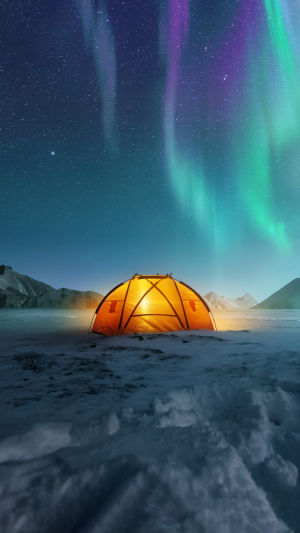Canada, a vast country, is a treasure trove of natural beauty, with breathtaking landscapes. One of the most fascinating natural wonders is the Northern Lights.
The Northern Lights are caused by the interaction of charged particles from the sun with gases in Earth's atmosphere.
In Canada, mainly areas located within the Arctic Circle, such as the Yukon Territory, Nunavut Territory, etc., can often enjoy this spectacular sight. When the solar wind carries charged particles against the Earth's magnetic field, these charged particles penetrate the atmosphere and collide with gas molecules in it.
During this process, the energy released causes the gases in the atmosphere to glow in various colors, forming the colorful northern lights.
The colors of the Northern Lights are varied, including green, red, purple, blue, etc. The changing colors make this landscape extraordinarily mysterious and charming. Against the background of the aurora, the snow-white ice field, the vast arctic forest, and the blue arctic ocean seem to be lit up, outlining a magnificent picture of the north.
Fortunately, Canada's Arctic region, with its remote and pristine environment, offers crystal-clear viewing conditions that make this spectacle even more humbling.
In addition to Canadian residents, the Northern Lights also attract tourists from all over the world. Every year during the aurora tourism season, the Canadian Arctic welcomes a large number of tourists. They pursue the dreamy light and shadow, stay away from the hustle and bustle, blend into the embrace of nature, and experience intimate contact with the wonders of the world.
However, with the impact of climate change and environmental pollution, the Northern Lights are also facing increasing threats. Scientists worry that climate change and human activity could affect the stability of Earth's magnetic field and atmosphere, weakening or disrupting the display of the Northern Lights.
Therefore, it is particularly important to protect the natural environment of the Northern Lights, and global efforts are needed to protect this natural miracle.
The Northern Lights in Canada are a miracle of nature and a mysterious interweaving between the Earth and the universe. It is not only a visual feast, but also a spiritual baptism.
In this magical land, the Northern Lights light up people's inspiration and hope, making us love and cherish this beautiful blue planet even more.
Let us work together to protect the Northern Lights and pass on this wonderful natural wonder to future generations so that they can also witness this miracle of heaven and earth in the days to come.
Camping in the Aurora Region is a unique experience that allows you to enjoy the great outdoors under the beautiful Northern Lights. However, due to the particularity of the aurora region and the severe cold weather conditions, camping requires more preparation and precautions.
Here are some things to keep in mind when camping in the Aurora Region:
1. Choose a suitable camping site: In the Aurora area, it is very important to choose a suitable camping site. Make sure to choose a more remote location away from the cities to reduce light pollution and make it easier to see the brilliant Northern Lights. In Canada, the Yukon and Nunavut territories are ideal locations for camping to see the Northern Lights.
2. Warm equipment: The temperature in the Aurora region can be very low, especially at night. It is important to bring enough warm gear, including warm sleeping bags, pajamas, down jackets, hats, gloves, and thermal socks. At the same time, pay attention to windproof and waterproof performance to deal with possible bad weather.
3. Anti-cold food and hot drinks: In extremely cold environments, food and drinks also need more attention. Choose high-energy cold-proof foods, such as nuts, chocolate, dried fruit, etc., and carry hot drinks, such as hot chocolate, tea, and soup, to maintain body temperature and strength.
4. Safety at night: The aurora usually appears at night, so make sure you are safe at night. Bring a headlamp or flashlight for moving and handling items at night. Avoid going too far from your campsite, and try to travel with your companions.
5. Best time to see the Northern Lights: It is important to know the best time to see the Northern Lights. The Northern Lights are usually most active between 10 pm and 2 am. During this time, try to stay in the open space of the campsite, away from artificial light sources, for the best viewing experience.
6. Anti-insect and wild animals: Although there are relatively few insects in the Aurora area, you still need to pay attention to anti-insect measures. At the same time, pay attention to the wild animals that may appear, especially bears and wolves. Keep a safe distance around the campsite and store food properly.
7. Activity plan and safety measures: When camping in the Aurora area, a detailed activity plan must be formulated and adequate safety measures must be taken. Try to stay safe with an experienced camper or consult a professional local guide.
Camping in the Aurora Region is an unforgettable experience, but it also requires care and preparation. By following the dos and don’ts above, you’ll be able to better appreciate the beauty of the Northern Lights while remaining safe and comfortable.





